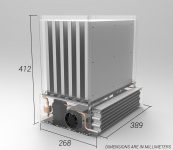Micro-Environmental Control System

Technology Description:
Syracuse University will develop a near-range micro-environmental control system transforming the way office buildings are thermally conditioned to improve occupant comfort. The system leverages a high-performance micro-scroll compressor coupled to a phase-change material, which is a substance with a high latent heat of fusion and the capability to store and release large amounts of heat at a constant temperature. This material will store the cooling produced by the compression system at night, releasing it as a cool breeze of air to make occupants more comfortable during the day. When heating is needed, the system will operate as an efficient heat pump, drawing heat from the phase-change material and delivering warm air to the occupant. The micro-scroll compressor is smaller than any of its type, minimizing the amount of power needed. The use of this micro-environmental control system, along with expanding the set-point range could save more than 15% of the energy used for heating and cooling, while maintaining occupant comfort.
Potential Impact:
If successful, DELTA technology could increase energy efficiency, reduce emissions produced by powering traditional HVAC systems, and enable more sustainable heating and cooling architectures for energy-efficient building design.
Security:
The innovations developed under the DELTA program have the potential to increase energy efficiency, improve overall building performance, and reduce HVAC energy consumption by at least 15%.
Environment:
The heating and cooling of buildings generates about 13% of the U.S. domestic greenhouse gas emissions. Through improved utilization of energy produced by fossil fuels with full adoption DELTA can reduce these emission by 2%.
Economy:
DELTA program innovations can help U.S. businesses eventually reduce reliance on tightly controlled building environments, thus enabling radical and sustainable architecture in next generation energy efficient building designs.
Contact
ARPA-E Program Director:
Dr. Marina Sofos
Project Contact:
Dr. Ed Bogucz
Press and General Inquiries Email:
ARPA-E-Comms@hq.doe.gov
Project Contact Email:
bogucz@syr.edu
Partners
United Technologies Research Center
Cornell University
Bush Technical, LLC
Air Innovations
Related Projects
Release Date:
04/29/2014
